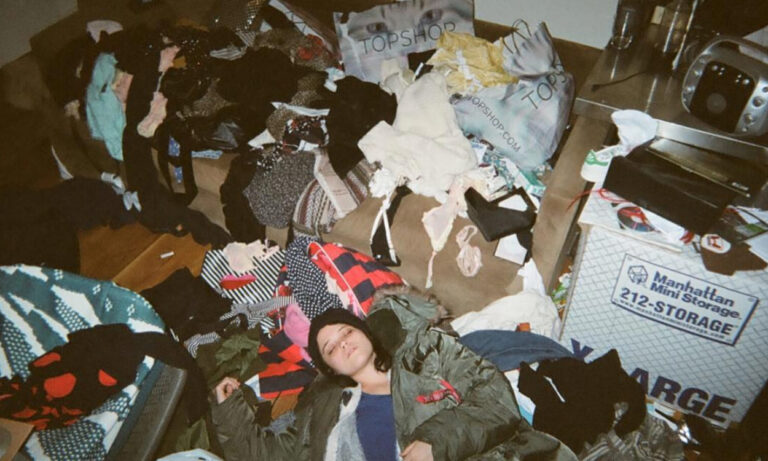Out with the ‘core’, in with the ‘sleaze’: the psychology behind the resurgence of indie sleaze
It’s out with the ‘core’ and in with the ‘sleaze’. We’re witnessing a TikTok tidal wave, where explosive fashion trends such clowncore and princesscore are already fading into the abyss, overshadowed by a much punkier, and shall we say, cool but effortless look: indie sleaze. Characterised by its participants as grunge aesthetic meets naughties glam, this new subculture is dominating netizens’ screens, and we’re here for it.
What is indie sleaze?
SCREENSHOT sat down with fashion and beauty aficionado Carol Carlovich to chat about curating an indie sleaze starter pack. According to the blogger, you’ll need “an indie band T-shirt, a plaid flannel shirt, knit beanie, pair of Dr. Martens, a vintage denim jacket, thick reading glasses, and a handful of polaroids.” Beauty-wise, she recommends a “smudged black eye, strong, well-drawn eyebrows, cat-eye black eyeliner, strong and cool-toned face contour, dark matte lips (MAC’s matte lipstick on the colour ‘Diva’, for example).”
@snoopdiamond As Kesha would say: get sleazy! #indiesleaze #greenscreen
♬ BRAND NEW BITCH - COBRAH
Carlovich perceives this reemerging subculture as “controlled rebellion” and describes it as “meticulously degraded and cool in just the right measure.” Like so many of our favourite fashion trends, indie sleaze was born in the late noughties.
Going into further detail, she explained: “It was an aesthetic popularised mostly around the 2010s by millennials and brings together the main elements of hipster culture like indie bands, lots of grunge and punk references mixed with glam, bubble gum pop. The party candids, the American Apparel ad photography, the adoration of anything vintage, the underground, and so on.”
@90sbaby2000s_teen #indiesleaze #indiesleazeaesthetic #indiesleazeinspo 😝🖤🫶✨💋
♬ i bet you look good on the dancefloor part 3 - carla
“Aesthetically, a lot of people see indie sleaze as a response to the 2009 recession, much guided by the deterioration of capitalism as viewed by the millennial teenagers who strived to have the purchasing power to identify with advertisements, but at the same time did not have any capital to do so,” she continued.
Ultimately, indie sleaze represents a rejection of hyper-femininity and instead opts for something that, while it may appear effortless, is, in reality, a detailed recreation of what we’d imagine a young millennial would wear to The 1975’s concert in 2014.
Of course, there are a number of variations of this aesthetic to play around with. For starters, there’s mermaid sleaze—a seaweed-entangled fantasy, most likely taking inspiration from the likes of Ursula and The Little Mermaid Disney film due to hit screens in 2023.
Oh, and don’t forget about ballet sleaze, a fashion aesthetic that resembles the chaos and calamity of Natalie Portman’s character in Black Swan. Imagine a room full of ballerinas wearing shredded leg warmers, distorted lace, and pink fingerless gloves.
@oldloserinbrooklyn 2022 insights - Parisian ballet #fashiontiktok #ballet #twee #fashiontrends2022 #tulle #indiesleaze
♬ Mozart Eine Kleine Nachtmusik - Violin
However, if you are ever confused about how to nail this fashion statement in question, look no further than the iconic Instagram account, @indiesleaze. From grunge dudes to seemingly nonchalant chicks, this page exemplifies everything the aesthetic stands for. Naturally, Alexa Chung is the primary inspiration, leader, saviour and godmother.
Why has ‘sleaze’ taken over ‘core’ aesthetics?
There has been an obvious shift among popular fashion TikTokers who are often now choosing to pick elements from the slightly more laid-back and effortlessly cool energy of sleaze, over the inherently preppy and potentially-rigid aspects of a number of core aesthetics.
On 14 October, the Digital Fairy—resident trend forecasters and marketing agency—posted a video letting netizens know that the masses were ditching their tutus for ripped tights and oversized tees.
@ ♬ -
Eager to learn more about the growing popularity, SCREENSHOT reached out to the Digi Fairy to gain some more insider perspective into why it believes this naughties revival is upon us. Culture specialist Rukiat Ashawe explained: “The trend cycle is impacted by cultural shifts in conjunction with the fast-paced nature of the internet.”
“Trends are circulating faster and wider as a result of fashion’s quickened dispersion via social media. Back in the day, it could take a trend that started in New York one year or more to reach the UK, but now a viral trend can cause an aesthetic to show up across different places across the world simultaneously,” she continued.
Confusingly enough, creative agencies and trend experts alike are slightly unsure as to why we’ve reached the naughties renaissance quite so quickly. Carlovich considered this in our chat and stipulated that indie sleaze is crawling its way back into our lives much earlier than initially predicted by fashion analysts.
“In fashion and beauty, there’s always a resurgence of past trends, usually recurring every 20 years or so. After we’ve seen the 90s and Y2K come back, it was evident that eventually, the 2010s aesthetic would follow right after. What’s interesting, though, is that we seem to be ten years too early, considering we’re only in 2022. Some people are arguing the reason for that is the fast-paced trend cycle induced by heavy social media usage added to, of course, TikTok’s impact on the music industry,” the creator noted.
Maybe another contributing factor to its online popularity is the fact that sleaze aesthetics inherently have a way of taking us down memory lane. Unlike many of the core looks which spawn online and come from in-the-moment, fresh ideas, sleaze has direct roots in nostalgia—it reminds us of all things Tumblr, alternative, darker, and moody. It harks back to a time when Meta didn’t exist, and the only AI we knew of came out of a Will Smith movie.
We all know the rapid speed in which trends appear and purge online. One minute, Elon Musk is getting slated for his perpetual pettiness, and the next, Jimmy Fallon has passed—it’s all very difficult to keep track of. Nevertheless, sleaze seems as though it’s here to stay.
Gen Zers are at the helm of sleaze aesthetics
From what we can see, gen Z is running the show when it comes to these burgeoning subcultures. Ashawe delved into why this might be: “Gen Z is looking at the hipster movement, Tumblr culture, and all those behaviours and aesthetics and is identifying with the feeling those millennial teenagers shared before them—of wanting to let go and create an effortlessly cool and unique image for themselves; of wanting to find an identity in their likings—a band, a show, their own personal style—of wanting to belong, in spite of what’s going on in the world.”
It’s true, while generation Alpha may reflect the future, gen Z reminds us of the recent past and the subsequent geopolitical, humanitarian, and climate crises we’ve faced over the past two decades. Young people often turn to creative expressions such as fashion to find comfort when they feel overwhelmed or distressed by the environment surrounding them.
Will indie sleaze stay relevant?
At the end of 2021, trend forecaster and analyst Mandy Lee, known online as @oldloserinbrooklyn, posted a TikTok declaring indie sleaze as the aesthetic of 2022. Her reasoning? The fact that, after the COVID-19 pandemic, people were craving creative expression and community.
The creator stated: “I feel like with the indie sleaze subculture, 15 years ago, community, art, and music were so powerful—that’s what brought people together. I think that specific elements, more so than the fashion, will become prevalent, as well as the style of photography, of course.”
@oldloserinbrooklyn Trend forecast: indie sleaze revival #trendcycle #nostalgia #tumblrfashion #indiekid
♬ Sex and the City (Main Theme) - TV Sounds Unlimited
What we want to avoid however, is indie sleaze becoming subverted online alongside the recent resurgence of heroin chic—a highly toxic trend which, during the 90s and early 2000s, celebrated extreme weight loss and fetishised eating disorders. With this current topic of conversation circulating online, concerns have begun to grow that soon, we’ll once again be fed videos and images on our social media pages promising ‘thinspiration’, while fashion brands reject body inclusivity in favour of what they consider to be a ‘model’ size.
Speaking with VICE about the rise of sleaze trends, Lee went on to clarify that these cyclical fashion aesthetics aren’t always an exact science. “It’s also worth mentioning that a prediction is just that: a prediction. You wait to see how and when and if it manifests. I think it’s ridiculous to think that a trend will copy and paste itself exactly,” she shared.
So, there we have it. Unlike Y2K which evokes a far more colourful, happier, and brighter emotion, indie sleaze is repping it for all of those who might be yearning to unleash their inner rebel—and with the current state of the world, we don’t really blame them.






